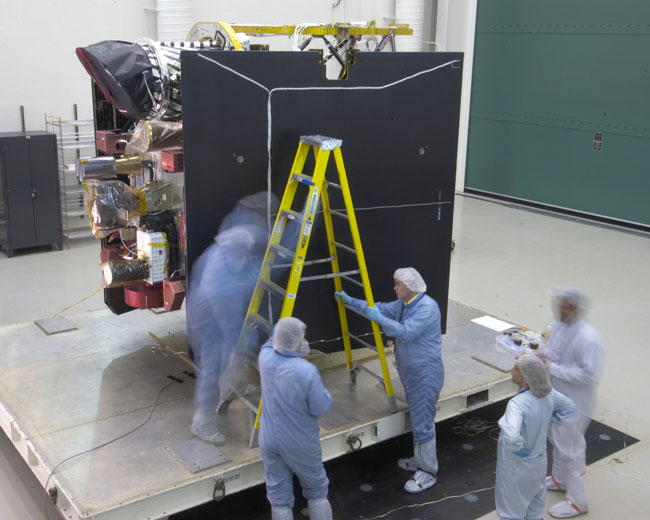Moving Day For Mars Reconnaissance Orbiter

KENNEDY SPACE CENTER, Florida - Nobody claims that getting to Mars is easy. But fighting snow on Earth can snarl even the best made plans.
NASA's Mars Reconnaissance Orbiter (MRO) arrived here Saturday in the early morning hours, boxed up and nitrogen-fed, after being hauled from Denver, Colorado aboard a huge C-17 Globemaster aircraft.
The flight was delayed due to a pounding snowstorm that struck the Denver area, slowing meticulous preparations by a trained squadron of "movers and shakers" that gathered at Lockheed Martin Space Systems facilities near Denver -- the birthplace of MRO.
First length of its far journey
"It is always exciting...knowing where it's going," said veteran semi-truck operator David Smith of the aerospace company, who drove MRO through traffic, at a speed of no more than 55 miles per hour. "We're taking it on the first length of its far journey...and that starts right here," he told SPACE.com.
With weather cold but calming, roads and highways cleared of traffic-halting accidents, an 11-vehicle procession of police, trucks, vans, and assorted vehicles slowly snaked their way to Buckley Air Force Base to load MRO and related hardware for its sky travel to this spaceport.
Hours of carefully orchestrated handling, by dozens of specialists, led to MRO's first-class seating within the C-17 cargo-carrying plane, operated by the 16th Airlift Squadron out of Charleston, Air Force Base, South Carolina.
Breaking space news, the latest updates on rocket launches, skywatching events and more!
Watchful eye of the loadmaster
Three huge boxes that carried MRO, its large main radio dish, and key electronic gear were wrestled inside the plane -- all under the watchful eye of the plane's "loadmaster".
Secured in place by chains and netting -- tied down so tight that even King Kong would surely have had a tough time escaping -- the space hardware made a roughly three-hour trek to the Kennedy Space Center.
The C-17 touched down on NASA's space shuttle runway early Saturday morning.
Work still to do
"It's wonderful to have it down here, to start the next and final phase," said Jim Graf, MRO Project Manager at the Jet Propulsion Laboratory, Pasadena, California.
"There's a tremendous amount of work yet to do. Integrating the whole spacecraft and doing additional testing. Then fuel MRO and mate it to the launch vehicle...getting it ready to go," Graf told SPACE.com.
MRO propellant loading starts in the middle of July. There are some ten weeks to finish up all the work, Graf said, with the spacecraft being prepped for its liftoff to Mars in early August.
"I'm ecstatic and overwhelmed to have it here. It has been a long four years to get it to this point. There have been lots of trials and tribulations just to see it down here on the ground," Graf said.
Sharing that view is Kevin McNeill, MRO program manager at Lockheed Martin Space Systems. "It's a good feeling to know that it's safely here. Now it's moving ahead, to get it all put together, tested and launched."
Reveal Mars as never before
MRO is the largest and most powerful Mars orbiter ever built. It will be launched on an Atlas 5, also built by Lockheed Martin. The booster was shipped earlier here to Florida onboard a Russian Antonov AN-124 cargo aircraft.
MRO's launch window opens August 10, and will take a 6-month journey across interplanetary space to reach Mars. Once orbiting the planet, the spacecraft is outfitted to reveal Mars as never before, making use of a powerful camera system and other instruments.
"This is a very important mission for the agency and for Mars exploration," said Ramon De Paula, Program Executive for Mars Exploration at NASA Headquarters in Washington, D.C.
"This mission is going to provide us some very unique science findings. It will make outstanding scientific contributions to Mars exploration...and getting it here today is a very important step in the process," De Paula said.

Leonard David is an award-winning space journalist who has been reporting on space activities for more than 50 years. Currently writing as Space.com's Space Insider Columnist among his other projects, Leonard has authored numerous books on space exploration, Mars missions and more, with his latest being "Moon Rush: The New Space Race" published in 2019 by National Geographic. He also wrote "Mars: Our Future on the Red Planet" released in 2016 by National Geographic. Leonard has served as a correspondent for SpaceNews, Scientific American and Aerospace America for the AIAA. He has received many awards, including the first Ordway Award for Sustained Excellence in Spaceflight History in 2015 at the AAS Wernher von Braun Memorial Symposium. You can find out Leonard's latest project at his website and on Twitter.
